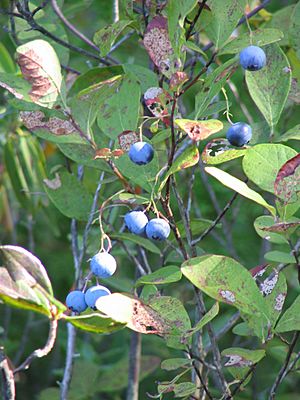New Jersey blueberry facts for kids
Quick facts for kids Vaccinium caesarienseNew Jersey blueberry |
|
|---|---|
 |
|
| Scientific classification | |
| Kingdom: | |
| (unranked): | |
| (unranked): | |
| Order: | |
| Family: | |
| Genus: | |
| Species: |
V. caesariense
|
| Binomial name | |
| Vaccinium caesariense Mack.
|
|
The Vaccinium caesariense, also known as the New Jersey blueberry, is a type of plant found in the Eastern United States. It belongs to the Vaccinium group of plants. This group also includes other tasty berries like blueberries, cranberries, huckleberry and bilberries.
Contents
Where New Jersey Blueberries Grow
The New Jersey blueberry is a plant that grows year after year. It is native to the Eastern United States. You can find it especially in the New Jersey area, which is how it got its common name. This plant grows along the coast, from Florida all the way up to New Hampshire. It almost always grows in wet areas, like wetlands.
What New Jersey Blueberries Look Like
The New Jersey blueberry plant has simple, small, oval-shaped green leaves. These leaves are present during the summer. In the winter, the plant loses its leaves. This plant is a dicot, which means its seeds have two main parts. It grows as a shrub. A shrub is a woody plant with many stems. It usually does not grow taller than 5 meters (about 16 feet).
How New Jersey Blueberries Are Grown
When people grow New Jersey blueberries for sale, they usually plant them in early fall or late winter. Farmers often use natural fertilizers like manure compost or vermicompost. Once the plants grow woody stems, they only need water during very dry times. These plants grow best in soil that is a bit acidic.
History of the Blueberry
The blueberry is one of the few fruits eaten in North America that first grew on this continent. Native Americans picked wild blueberries long ago. They used the plant to make a dye for coloring items. They also used it as a medicine for stomach problems. Early European settlers in America started using the fruit in their food and as medicine too.
New Jersey's Special Blueberry
New Jersey has special programs to protect and grow the New Jersey blueberry. These include the Blueberry Plant Certification Program. There is also the Phillip E. Marucci Center for Blueberry & Cranberry Research & Extension. These programs help keep the blueberry industry strong.
New Jersey's Blueberry Story
The state of New Jersey has officially recognized the importance of its native blueberry. The highbush blueberry, which is native to New Jersey, was first grown for sale there. This was thanks to the hard work of Elizabeth White and Dr. Frederick Coville in the early 1900s. They studied and bred blueberries at Whitesbog, New Jersey. Their work helped start a whole new farming industry.
Blueberries are very good for you! They taste great and are full of fiber, vitamin C, and antioxidants. They have no sodium or cholesterol and are low in calories. Blueberries can even help prevent cancer and heart disease. New Jersey is a top blueberry producer, growing about 21% of all blueberries in the nation. This is about 38 million pounds each year! New Jersey is known as the "blueberry capital" of the country. The highbush blueberry is a perfect symbol of a healthy and delicious fruit.
New Jersey's Hybrid Blueberry
Even though the original New Jersey blueberry still grows in the wild, most blueberries grown in New Jersey today are a special hybrid type. This hybrid is called the Highbush blueberry. It was first developed by Elizabeth Coleman White. She was the daughter of a cranberry farmer. This new blueberry was introduced in Whitesbog, Burlington County, New Jersey. During harvest season, farmers in New Jersey often sell fresh blueberries at roadside stands. This special hybrid fruit keeps its good quality and taste even after being frozen and then thawed.

